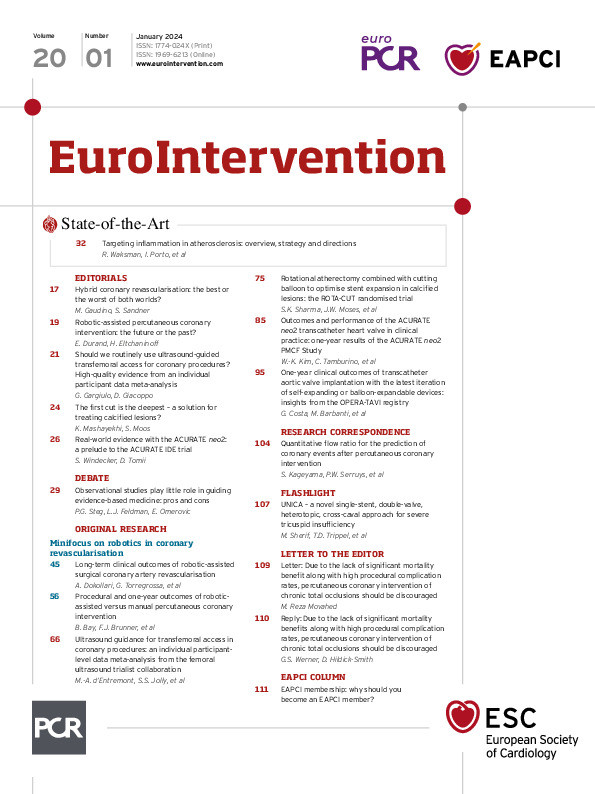In this issue of EuroIntervention, Dokollari et al1 report the outcomes of 2,280 patients who underwent robotic-assisted coronary artery bypass grafting (CABG) procedures between 2005 and 2021, of which 868 (38%) were performed as hybrid coronary revascularisation (HCR) procedures. These procedures consisted of robotic-assisted left internal thoracic artery (LITA)-to-left anterior descending (LAD) CABG via a left thoracotomy and subsequent percutaneous coronary intervention (PCI) of non-LAD target vessels. The authors analysed outcomes over three 5-year periods during which the proportion of HCR procedures increased substantially, rising from 25.5% between 2005 and 2010 to 48.4% between 2017 and 2021.
This analysis draws on the extensive experience of a dedicated centre for robotic coronary surgery. Despite an increasing burden of patient comorbidities, perioperative and postoperative outcomes improved significantly over the course of the study period, highlighting the fact that robotic-assisted, minimally invasive CABG is a complex operation that is associated with a considerable learning curve.
Appropriately, the authors reserved HCR for patients deemed unsuitable for conventional CABG by the local Heart Team. However, in the last years of their study, this proportion of patients was much higher than is generally reported by other centres, indicating a bias toward HCR in this particular centre.
Beyond this niche experience from a dedicated centre for robotic coronary surgery, the role of HCR in current practice remains largely unclear. Intuitively, HCR only makes sense if the surgical portion is performed using sternal-sparing approaches. The minimally invasive LITA-LAD CABG is a technically complex operation that is difficult to standardise and perform on a routine basis. The National Heart, Lung, and Blood Institute-sponsored, randomised Hybrid Trial (Hybrid Coronary Revascularization Trial)2, designed to investigate whether HCR was superior to multivessel PCI, ended prematurely because of low enrolment due to a lack of expertise and confidence with minimally invasive CABG techniques in the surgical community. Given the described volume-to-outcome relationship, HCR as a routine procedure would need to be performed in dedicated centres that are already experienced in minimally invasive CABG, which would lead to obvious logistical and access issues.
Does HCR, as the authors write, offer “the best of both worlds” to all CABG patients? We think not. Surgical CABG grafts are placed several centimetres distal to the stenosis, thereby protecting not only against flow-limiting plaque but also against the progression of other proximal lesions that are non-flow limiting at the time of surgery. This “surgical collateralisation” is the postulated mechanism for the reduction in spontaneous myocardial infarction and mortality seen in some clinical trials comparing CABG with PCI, which only treats the flow-limiting lesions3. This benefit of CABG is obviously lost with HCR, where a surgical collateral is only built in the LAD territory. If we were to regard non-LAD target vessels as irrelevant to outcomes in patients with complex multivessel disease, the current evidence of clinical benefits when using conduits with better patency rates for non-LAD targets would be difficult to explain45. On the other hand, if it is a quick recovery from the procedure and an improved short-term quality of life that are important to the patient, then HCR obviously cannot compete with multivessel PCI.
As randomised evidence is lacking, the role of HCR beyond carefully selected patient subgroups remains to be determined, and therefore, the technique should currently be regarded as a niche area of clinical research rather than part of clinical practice.
Conflict of interest statement
The authors have no conflicts of interest to declare.

